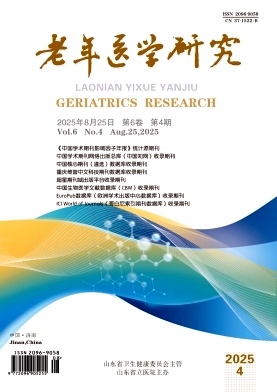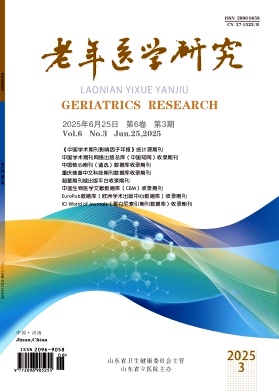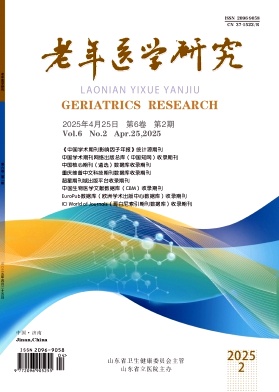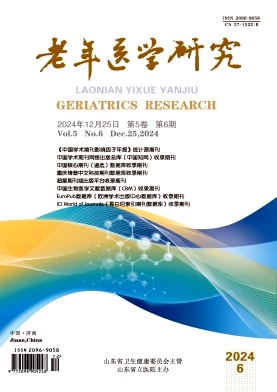Tracking the information about your manuscript
Communicate with the editorial office
Query manuscript payment status Edit officeCollecting, editing, reviewing and other affairs offices
Managing manuscripts
Managing author information and external review Expert Information Expert officeOnline Review
Online Communication with the Editorial Department
Download Center
Page Views
Information

Geriatrics Research
CN: 37-1522/R
ISSN: 2096-9058
Governed by: Health Commission of Shandong Province
Sponsored by: Shandong Provincial Hospital Affiliated to Shandong First Medical University
Editor-in-Chief: SUN Zhijian
Deputy Editor-in-Chief: WANG Jianchun
Founded in 2020, bimonthly.
Indexed by: CNKI, Wanfang, Weipu, Chaoxing, CBM.
Establishment and application of an information management platform for comprehensive geriatric assessment
DONG Yan;ZHANG Xin;WANG Ying;WANG Le;SHI Yu;LIU Jia;ZENG Yan;WANG Jianchun;LV Hong;Objective To establish an information management platform for comprehensive geriatric assessment(CGA) and explore its application. Methods A multidisciplinary team was formed to develop the CGA information platform. Based on domestic and international guidelines and expert consensus, CGA items and tools were screened and determined, and evidence-based personalized health guidance recommendations were formulated. The platform was constructed with three main interfaces: homepage, assessment, and results/health guidance. The Likert 5-point scaling method was used to assess the usefulness, information quality, interface quality and overall impression of the platform by geriatric nurses who used it. Results The platform could conduct assessments across 15 domains, including physical function, nutrition, cognition, sleep, depression, frailty, sarcopenia, swallowing disorders, and urinary incontinence, generating a CGA report and health guidance recommendations. The multidisciplinary team implemented personalized health interventions for patients identified as at-risk through screening, achieving closed-loop management of "assessment-intervention-follow-up" for both outpatient and inpatient elderly patients. A total of 86 geriatric department nurses used the platform to complete 3 930 CGAs. The platform received high ratings across key dimensions: usefulness 4. 76±0. 53, information quality 4. 70±0. 58, interface quality 4. 74±0. 51, and overall evaluation 4. 74±0. 51. Conclusion The CGA information management platform is successfully established, which is highly feasible and good usability.
Application of mobile health in older adults with frailty: a scoping review
ZHAI Yaxian;LIU Yudan;LI Huifang;WANG Ling;YANG Jinmei;DENG Wei;Objective To conduct a scoping review on the current state of application, key components, and effectiveness of mobile health(mHealth) in frail older adults. Methods The scope reviews guidelines released by the Joanna Briggs Institute(JBI) in Australia was used as the methodological framework. PubMed, Embase, CINAHL, The Cochrane Library, CNKI, WanFang, and VIP databases were systematically retrieved. The search period spanned from the inception of each database to January 5, 2025. The retrieved literature was summarized and analyzed. Results A total of 17 studies were included. The forms of mHealth interventions encompassed mobile Apps, WeChat mini-programs, wearable devices, and web-based platforms. The application of mHealth in frail older adults primarily involved frailty prediction assessment and screening, transitional care, personalized intervention, and providing health behavior guidance. Outcome measures included physical function, the accuracy and effectiveness of frailty prediction/assessment, psychological status and social support, nutritional and cognitive status, feasibility and acceptance. Conclusion The application of mHealth demonstrates advantages in the management of frail older adults and can effectively improve their health outcomes and quality of life.
A review of the scope of the application of Internet-based Cognitive Behavioral Therapy in psychological interventions for elderly patients
WANG Shuo;ZHAO Yaqi;GAO Chuanxu;WEI Longjie;LI Bin;Objective A scoping review was conducted on research regarding the application of Internet-based Cognitive Behavioral Therapy(ICBT) in psychological interventions for elderly patients, aiming to clarify the types and contents of interventions, intervention outcome indicators, and effects. Methods Relevant studies were systematically searched in PubMed, Embase, Web of Science, The Cochrane Library, CNKI, WanFang, VIP Database, and Chinese Biomedical Literature Database(CBM), with the search time limit from the establishment of the databases to April 27, 2025. The included literatures were analyzed and summarized. Results A total of 13 studies were included. The included elderly patients were from outpatient clinics, communities, and long-term care institutions. Their main symptoms were depression and anxiety. The core patient group consists of patients with simple anxiety and depression; as well as those with physical comorbidities such as post-hip replacement, age-related macular degeneration, and knee osteoarthritis complicated with depression. The outcome indicators mainly covered depression, anxiety, cognitive function, quality of life, treatment adherence, and intervention acceptance. Conclusions ICBT is applicable to elderly patients with mild-tomoderate depression, anxiety, and physical comorbidities. Through multidisciplinary collaboration and the implementation of age-adapted programs for the elderly, it can effectively alleviate symptoms and has cost-effectiveness advantages.
Research progress on the diagnosis and treatment of myasthenia gravis in traditional Chinese medicine based on data mining technology
SHI Kun;MENG Xianzhi;LI Miaomiao;Myasthenia gravis is an acquired autoimmune disorder of neuromuscular junction transmission. In traditional Chinese medicine(TCM), it falls within the category of “ Wei Syndrome”. This paper reviews the application of datamining techniques in elucidating the etiology and pathogenesis, symptom-pattern correlations, therapeutic regularities, and outcome prognoses of myasthenia gravis. The advantages of data mining in TCM diagnosis and treatment are fully discussed to provide references for clinical management of myasthenia gravis.
Research progress of the elderly in seek medical treatment technology anxiety under the perspective of digital intelligence
LI Jianchun;LIU Yudan;LIANG Changping;DENG Wei;ZHANG Zhilian;SHEN Yunxia;With the acceleration of the digital transformation process, the "integration of digital and artificial intelligence" characterized by the deep integration of big data and artificial intelligence is reshaping the medical service system, and the global digital medical industry is developing rapidly. While technological progress and innovation bring convenience and opportunities, they also lead to anxiety about medical technology, affecting the willingness and ability of the elderly to use relevant seek medical technologies, thereby limiting their access to digital health benefits. This article reviews the concept, influencing factors, evaluation tools, and intervention measures of seek medical treatment technology anxiety, aiming to raise awareness among healthcare professionals about the anxiety of the elderly regarding seek medical treatment technology and to provide a reference for targeted nursing interventions.





























